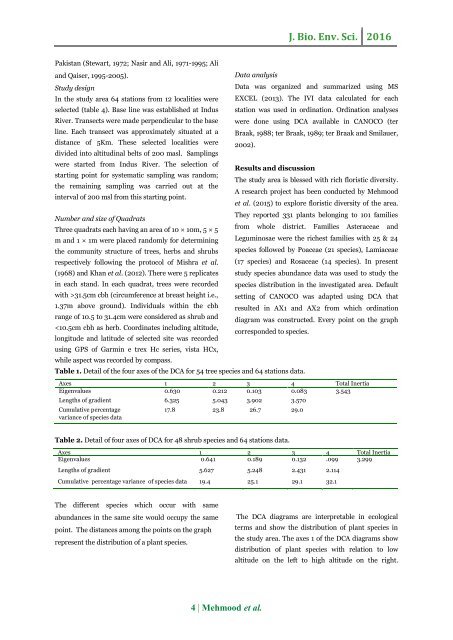Deterended correspondence analysis of vegetation in district tor ghar, Westrn Himalaya
Abstract District Tor Ghar is phytosocilogically unexplored region in the western Himalaya. Field survey was carried out during the summers of 2012 and 2013 to study floristic diversity in the region. The vegetation data collected from whole district was analyzed using DECORANA, computer programs. Species abundance data were used in CANOCO version 4.5 for DCA. Deterended correspondence analysis (DCA) identified three vegetation zones in the study area on the basis of ecological amplitude. The results were interpreted with major environmental gradients. Ordination of the site and species for herbs, shrubs and trees reported from study area by DCA indicated that the 1st two axes showed best correlation and eigenvalues from 3rd and 4rth axes revealed less representation. The distribution of plant species on DCA axis 1 indicated that altitude was the main gradient affecting the distribution of most of the plant species. Some species showed no correlation with other plants which was indication of specific locality. The Ordination diagram revealed that the plants of habitats located at the left side of the DCA diagram representing humid subtropical habitat which were more influenced by anthropogenic disturbances. The plant species located at right side of the ordination diagram showing moist temperate and sub alpine habitats. The results of the present research also revealed that elevation, temperature and slope were the main factor affecting the distribution of plant species. These results will be used as base line to study vegetation analysis in future with reference to different ecological conditions.
Abstract
District Tor Ghar is phytosocilogically unexplored region in the western Himalaya. Field survey was carried out during the summers of 2012 and 2013 to study floristic diversity in the region. The vegetation data collected from whole district was analyzed using DECORANA, computer programs. Species abundance data were used in CANOCO version 4.5 for DCA. Deterended correspondence analysis (DCA) identified three vegetation zones in the study area on the basis of ecological amplitude. The results were interpreted with major environmental gradients. Ordination of the site and species for herbs, shrubs and trees reported from study area by DCA indicated that the 1st two axes showed best correlation and eigenvalues from 3rd and 4rth axes revealed less representation. The distribution of plant species on DCA axis 1 indicated that altitude was the main gradient affecting the distribution of most of the plant species. Some species showed no correlation with other plants which was indication of specific locality. The Ordination diagram revealed that the plants of habitats located at the left side of the DCA diagram representing humid subtropical habitat which were more influenced by anthropogenic disturbances. The plant species located at right side of the ordination diagram showing moist temperate and sub alpine habitats. The results of the present research also revealed that elevation, temperature and slope were the main factor affecting the distribution of plant species. These results will be used as base line to study vegetation analysis in future with reference to different ecological conditions.
Create successful ePaper yourself
Turn your PDF publications into a flip-book with our unique Google optimized e-Paper software.
J. Bio. Env. Sci. 2016<br />
Pakistan (Stewart, 1972; Nasir and Ali, 1971-1995; Ali<br />
and Qaiser, 1995-2005).<br />
Study design<br />
In the study area 64 stations from 12 localities were<br />
selected (table 4). Base l<strong>in</strong>e was established at Indus<br />
River. Transects were made perpendicular to the base<br />
l<strong>in</strong>e. Each transect was approximately situated at a<br />
distance <strong>of</strong> 5Km. These selected localities were<br />
divided <strong>in</strong>to altitud<strong>in</strong>al belts <strong>of</strong> 200 masl. Sampl<strong>in</strong>gs<br />
were started from Indus River. The selection <strong>of</strong><br />
start<strong>in</strong>g po<strong>in</strong>t for systematic sampl<strong>in</strong>g was random;<br />
the rema<strong>in</strong><strong>in</strong>g sampl<strong>in</strong>g was carried out at the<br />
<strong>in</strong>terval <strong>of</strong> 200 msl from this start<strong>in</strong>g po<strong>in</strong>t.<br />
Number and size <strong>of</strong> Quadrats<br />
Three quadrats each hav<strong>in</strong>g an area <strong>of</strong> 10 × 10m, 5 × 5<br />
m and 1 × 1m were placed randomly for determ<strong>in</strong><strong>in</strong>g<br />
the community structure <strong>of</strong> trees, herbs and shrubs<br />
respectively follow<strong>in</strong>g the protocol <strong>of</strong> Mishra et al.<br />
(1968) and Khan et al. (2012). There were 5 replicates<br />
<strong>in</strong> each stand. In each quadrat, trees were recorded<br />
with >31.5cm cbh (circumference at breast height i.e.,<br />
1.37m above ground). Individuals with<strong>in</strong> the cbh<br />
range <strong>of</strong> 10.5 to 31.4cm were considered as shrub and<br />





![Review on: impact of seed rates and method of sowing on yield and yield related traits of Teff [Eragrostis teff (Zucc.) Trotter] | IJAAR @yumpu](https://documents.yumpu.com/000/066/025/853/c0a2f1eefa2ed71422e741fbc2b37a5fd6200cb1/6b7767675149533469736965546e4c6a4e57325054773d3d/4f6e6531383245617a537a49397878747846574858513d3d.jpg?AWSAccessKeyId=AKIAICNEWSPSEKTJ5M3Q&Expires=1715504400&Signature=69pnSqvkwARF1BKfEA3povuXPq4%3D)











